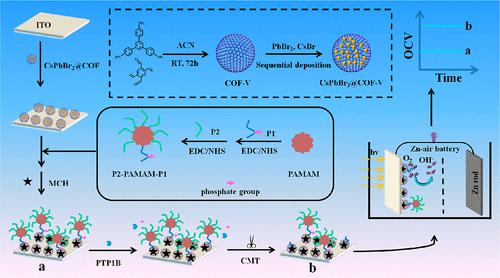当前位置:
X-MOL 学术
›
Anal. Chem.
›
论文详情
Our official English website, www.x-mol.net, welcomes your
feedback! (Note: you will need to create a separate account there.)
Zinc–Air Battery-Assisted Self-Powered PEC Sensors for Sensitive Assay of PTP1B Activity Based on Perovskite Quantum Dots Encapsulated in Vinyl-Functionalized Covalent Organic Frameworks
Analytical Chemistry ( IF 6.7 ) Pub Date : 2022-06-24 , DOI: 10.1021/acs.analchem.2c01702 Ke Xiao 1 , Rong Zhu 1 , Cuicui Du 1 , Hejie Zheng 1 , Xiaohua Zhang 1 , Jinhua Chen 1
Analytical Chemistry ( IF 6.7 ) Pub Date : 2022-06-24 , DOI: 10.1021/acs.analchem.2c01702 Ke Xiao 1 , Rong Zhu 1 , Cuicui Du 1 , Hejie Zheng 1 , Xiaohua Zhang 1 , Jinhua Chen 1
Affiliation

|
The self-powered sensors have attracted widespread attention in the analysis field due to a huge demand of point-of-care testing (POCT) in the early diagnosis of diseases. However, the output voltage of the reported self-powered sensors is always small, resulting in a narrow linear detection range and low assay sensitivity. Herein, a self-powered photoelectrochemical (PEC) sensor with zinc–air batteries as a power source was developed for activity assay of protein tyrosine phosphatase 1B (PTP1B) based on perovskite quantum dots encapsulated in the vinyl-functionalized covalent organic framework (COF-V). CsPbBr3 nanocrystals were stabilized by the confinement effect of the COF-V cage without aggregation, and the resulting CsPbBr3@COF-V composite was used as the cathodic photoelectric material to construct the zinc–air battery with a large open-circuit voltage (OCV, 1.556 V). Before PTP1B activity assay, an auxiliary peptide–polyamidoamine–phosphopeptide (P2-PAMAM-P1) hybrid was introduced into the photocathode via thiol–ene click reaction between the thiol group on the P1 and the vinyl group on the COF-V. The steric hindrance effect of the P1-PAMAM-P2 hybrid inhibited the PEC performance of the photocathode, resulting in a small OCV of the zinc–air battery. When the PTP1B existed, PTP1B-catalyzed dephosphorylation of tyrosine on P1 facilitated the cleavage process of P1 by chymotrypsin, leading to the removal of the P2-PAMAM-P1 hybrid from the photocathode and consequently the enhancement of the OCV. Therefore, the activity of PTP1B was sensitively detected. The developed self-powered PEC sensor showed superior performance for PTP1B activity assay (broad linear response range, 0.1 pM to 10 nM and low detection limit, 0.032 pM) due to the large output voltage of the constructed zinc–air battery and has great potential in POCT of protein phosphatase-related diseases and the discovery of protein phosphatase-targeted drugs.
中文翻译:

锌-空气电池辅助自供电 PEC 传感器用于基于乙烯基功能化共价有机框架封装的钙钛矿量子点灵敏测定 PTP1B 活性
由于在疾病早期诊断中对即时检测(POCT)的巨大需求,自供电传感器在分析领域引起了广泛关注。然而,报告的自供电传感器的输出电压总是很小,导致线性检测范围窄,检测灵敏度低。在此,基于封装在乙烯基官能化共价有机框架(COF-五)。CsPbBr 3纳米晶体通过 COF-V 笼的限制效应稳定而不聚集,得到的 CsPbBr 3采用@COF-V复合材料作为阴极光电材料,构建了具有大开路电压(OCV,1.556 V)的锌空气电池。在 PTP1B 活性测定之前,辅助肽-聚酰胺胺-磷酸肽 (P2-PAMAM-P1) 杂化物通过 P1 上的硫醇基团和 COF-V 上的乙烯基基团之间的硫醇-烯点击反应引入光阴极。P1-PAMAM-P2 杂化物的空间位阻效应抑制了光电阴极的 PEC 性能,导致锌-空气电池的 OCV 较小。当 PTP1B 存在时,PTP1B 催化的 P1 上酪氨酸的去磷酸化促进了胰凝乳蛋白酶对 P1 的裂解过程,导致 P2-PAMAM-P1 杂合体从光阴极中去除,从而提高了 OCV。因此,可以灵敏地检测到 PTP1B 的活性。
更新日期:2022-06-24
中文翻译:

锌-空气电池辅助自供电 PEC 传感器用于基于乙烯基功能化共价有机框架封装的钙钛矿量子点灵敏测定 PTP1B 活性
由于在疾病早期诊断中对即时检测(POCT)的巨大需求,自供电传感器在分析领域引起了广泛关注。然而,报告的自供电传感器的输出电压总是很小,导致线性检测范围窄,检测灵敏度低。在此,基于封装在乙烯基官能化共价有机框架(COF-五)。CsPbBr 3纳米晶体通过 COF-V 笼的限制效应稳定而不聚集,得到的 CsPbBr 3采用@COF-V复合材料作为阴极光电材料,构建了具有大开路电压(OCV,1.556 V)的锌空气电池。在 PTP1B 活性测定之前,辅助肽-聚酰胺胺-磷酸肽 (P2-PAMAM-P1) 杂化物通过 P1 上的硫醇基团和 COF-V 上的乙烯基基团之间的硫醇-烯点击反应引入光阴极。P1-PAMAM-P2 杂化物的空间位阻效应抑制了光电阴极的 PEC 性能,导致锌-空气电池的 OCV 较小。当 PTP1B 存在时,PTP1B 催化的 P1 上酪氨酸的去磷酸化促进了胰凝乳蛋白酶对 P1 的裂解过程,导致 P2-PAMAM-P1 杂合体从光阴极中去除,从而提高了 OCV。因此,可以灵敏地检测到 PTP1B 的活性。











































 京公网安备 11010802027423号
京公网安备 11010802027423号